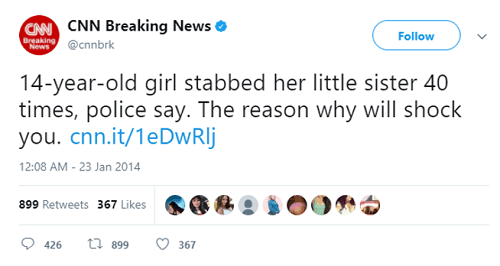How to Know if a News Website or Story is Credible and Reliable
By Kay FleuryUpdated on August 19, 2024

The prevalence and accessibility of online news is an incredible thing; it allows us to gain important information in an instant, and stay updated on world events continuously, with very little effort. But when you put too little effort into identifying whether the news stories you’re reading are legitimate, you occasionally end up falling victim to believing that a made-up story or propaganda is factual, and a real news story.
If you like sharing news on your social media accounts and with your friends, then it’s your social responsibility to make sure that information is accurate. Not to mention, if you share news all the time and a story you post turns out to be fake, your entire reputation may be at stake! In this article, we’ll help preserve your online reliability by teaching you:
If you want to know where to draw the line between a reliable news source and a story intended to get a lot of shares, this article will help you, as will our ultimate guide to fake news. Read on to become an instant expert on news biases and credibility.
What is bias in news?
Bias in news can exist in many ways, including decisions about what should be emphasized, the choice not to include specific known facts, and the personal moral beliefs of journalists, reporters, and news producers, affecting the way stories are written, reported, and covered across media outlets.

Some online news resources and websites will intentionally choose not to report on something if it doesn’t line up with their personal views – especially when politics is involved. They may also craft false stories or arrange stories based on loose observations, making it seem as though something happened when it didn’t. It’s important to be able to recognize when you’re reading a biased story, and when the story you’re reading is factual and credible.
These are the best ways to tell when you’re being duped, and when the news story is legit.
8 ways to tell a news story is not credible
1. There are no sources.
If a story doesn’t contain sources, it’s not credible. Most reliable journalistic outlets won’t be afraid to state where their information is coming from. So if a news source intentionally hide this information, chances are the “facts” are made up. News organizations like BBC or The New York Times always mention their sources when publishing articles.
How to combat it: Always check for sources, either at the end of the article, or within the text. Usually it will be outright stated where the information is coming from right at the beginning of the article. “According to [X]…” or “[X] has now shown that…” are usually good phrases to look for within the article.
2. The author is ambiguous.
Though the author may not be trying to present false information as fact, the information you’re reading may not be overly verifiable. If the author writes an ambiguous article that strays away from stating things with confidence, they may just be trying to encourage people to draw their own conclusions while sharing the story.
How to combat it: Look for direct statements and facts that are well-outlined. Try to find specific facts within the writing.
3. The headline is total clickbait.

Headlines that shout at you in all capital letters, or end with ellipses generally don’t have valid information, and instead, is merely trying to encourage you to click and read the story. The principle behind this is simple: why would you want to read a story when you don’t even know what the topic is? If they need to make it so enticing to get you to click on it, then the story is probably made up – otherwise, the title would speak for itself.
How to combat it: Avoid news stories with all caps titles, celebrity names, and phrases like “you won’t believe” or “you never saw this coming…”
4. The intent is for social media sharing.
Sometimes when reading an article, you can tell that its intention is to get many shares on social media, and potentially go viral. When this is the purpose, the story generally aims to pull at the reader’s heart, appealing to their emotions. This means the story may be embellished a little, hoping that your immediate reaction will cause you to share the story, rather than taking the time to think through what you’ve read.
How to combat it: Don’t share based on immediate emotional reactions. If a story makes you overly emotional, try fact-checking it or seeing if you can find the same story on another website before you hit that Share button.
This website is a great place to check out the bias of popular stories trending now, to see if you should still share that story you just found that seems newsworthy.
5. There is more argument than facts presented.
A news story should present facts in an unbiased way, leaving the reader to develop their own interpretation of the events that occurred. Though there’s always an angle to a story, even one that exposes something should leave the reader to draw their own conclusions – for the most part. If the story contains more argumentative claims than factual statements, then chances are the story is overly biased.
How to combat it: Think about the statements that spoke to you the most in the article, and decide if they are factual and unbiased, or if they are mainly argumentative. Look for phrases like “this means,” “it follows that,” or “obviously” to pick out argumentative statements.
6. The images are copied from another source.
If the story is accompanied by and image (which is probably unflattering), it’s possible it was just taken from another website, meaning the story could have been too. In this case, usually the content is taken from another website, and just re-written in haste to get it online faster.
How to combat it: Right-click on the image in the Google Chrome web browser and click Search for image in Google. This will show you if the same image was used on other websites, and can help you determine if it’s an original photo from a credible source, or was taken from another news source.
7. The “About Us” section indicates a clear bias – usually political/moral.

When it comes to news websites, typically the “About Us” section will explain any outright political or moral biases the website has. A site that is proud of its bias or tries to attract a specific demographic will generally admit to these biases, though many sites try to disguise their angle by claiming to be “unbiased” or to “report the truth.”
How to combat it: Do some research about the website on other websites if their “About Us” section is ambiguous. Also, look for keywords related to any specific political affiliation or sponsored organization.
8. The advertisements are for dodgy products/other unrealistic stories.
If the ads you see on the rest of the website are for “too-good-to-be-true” products, other unbelievable stories, or clickbait articles, then the chances are this article is not very reliable. If legitimate companies aren’t willing to advertise on the site, that’s an indicator that there may be something less than reliable about the news site.
How to combat it: Scroll down the page right away and look for banner ads on the sides and bottom of the story, as well as a section on “related stories” or “stories you may also be interested in.” If these don’t look legitimate, the story you’re currently reading probably isn’t either.
Quick steps to take when assessing an unfamiliar news site
So now you know the basics, and have a good idea about what to look for when reading your next news story. Now, your goal is to make sure you avoid fake news websites, because you don’t want to be the one helping to support certain politicians based on information you got on fake news websites.
Next time you pull up a story, work through these quick steps to help you determine the legitimacy of the website itself; even if an individual story is mostly credible, you may still want to exercise caution and evaluate the website.
Here are the main things you should look for when reading a news story on an unfamiliar site:
- About Us – Reading the “About Us” page is the first step, and will make it easy to know right away what the purpose of the site is – though you should take these statements with a grain of salt. This page will often contain a mission statement and the goals of the site, which can help you identify outright biases, though these may not be so blatantly stated.
- Author and date – Make sure you check for an author’s name, and date for an article. If these aren’t present, there is a good chance that the website isn’t legitimate.
- Formatting – Look for things such as titles all in caps, or click bait headlines like “You’ll never believe what [this] person did” are dead giveaways that the news stories are trying to entice you to click on them or make a direct statement, rather than reporting factual information that would speak for itself.
- Sources – Within each article, there should be sources for the statements being made – especially if they are outlandish. Always look throughout the article for citations or a statement at the end that explains where the information came from.
- Advertisements – Always look for ads on the news story pages, and decide if they appear to be legitimate. Sometimes the ads are for ridiculous items or additionally unbelievable stories, which is often an indication that the story isn’t very reliable.
Hopefully you’re an expert now on knowing when a news article is credible or not. We also have guides on the best apps and tools out there for keeping up to date with the news, such as our guide on how to find unbiased news online.